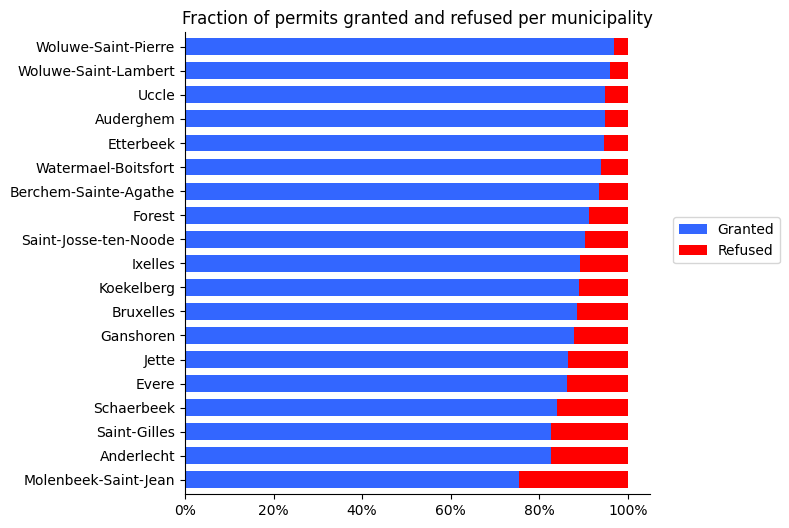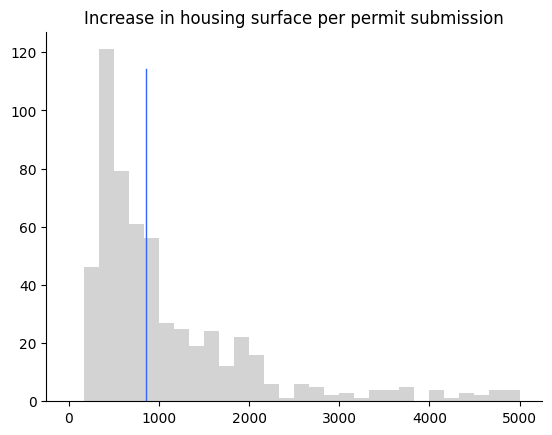All permits in Brussels are available on the OpenPermits platform. We have analyzed these permits to extract interesting statistics on permits applied for and granted in Brussels.
Planning permission
Planning permission is required for a number of construction and conversion projects. These are specified in the CoBAT, the legal basis for town and country planning in Brussels.
An increasing number of requests
As can be seen from the graph below, the number of permits applied for has been rising steadily for over 20 years. Each year, we record an average of 173 more permits than the previous year. In 2022, for example, 7784 permits were applied for in the Brussels-Capital Region.

Significant disparities between communes
As the illustration below shows, some communes are much more active in terms of the number of permits applied for. Brussels-City leads the way with 15% of applications, while Saint-Josse-ten-Noode accounts for just 1% of the total volume of permits.

Of course, not all permit applications are granted, and there are significant differences in the rate at which permits are granted depending on the commune.
89% of permits granted
Communes in the south-east of Brussels (Woluwé, Uccle, Auderghem, Etterbeek, Watermael) grant a higher percentage of permits than communes in the north (Schaerbeek, Evere, Anderlecht, Molenbeek). This rate varies between 75% (Molenbeek) and 95% (Woluwe-Saint-Pierre) , with an average of 89%. It is important to note that town planning permits include requests for acts that are not construction (e.g.: insulating a gable, regularizing a dwelling, felling a tree, etc.).

Housing development projects
The construction of residential buildings is subject to planning permission. These projects can be identified, via the permit application, by an increase in the surface area allocated to housing, as well as keywords such as "construction", "renovation", "apartment building", etc. We have therefore identified 630 projects corresponding to these criteria.
Here are a few examples that fit this definition:
- Demolition of a car garage and reconstruction of an apartment building
- Building extension to accommodate 4 new apartments
- Conversion of an office building into housing
Which features?
Development projects vary greatly in size. We have selected only those projects for which at least 300m2 of housing was created. The majority of housing development permits plan to create less than 850m2 of housing. The 10% most ambitious projects aim to create 5000m2 or more.

Our biggest upcoming projects
Based on the established criteria, we have isolated the permits with the most m² authorized over the last 3 years. These are the upcoming projects.

| Reference | Address | Accepted housing area [m2] |
|---|---|---|
| 18/PFD/1791015 | Rue Neerveld 105-107, 1200 Woluwe-Saint-Lambert | 15375.0 |
| 12/PFD/1767823 | Quai des Charbonnages 88-90, 1080 Molenbeek-Saint-Jean | 12183.43 |
| 06/PFD/1772514 | Rue Colonel Bourg 120, 1140 Evere | 11843.5 |
| 16/PFD/1760152 | Homborch 71a-71e, 1180 Uccle | 9500.1 |
| 09/PFD/1839512 | Avenue de la Couronne 486-498, 1050 Ixelles | 8264.5 |
| 18/PFD/1825155 | Rue d'Attique , 1200 Woluwe-Saint-Lambert | 7592.41 |
| 15/PU/1779437 | Rue des Coteaux 221-223, 1030 Schaerbeek | 7574.4 |
| 01/PFD/1784916 | Rue de la Filature , 1070 Anderlecht | 7125.0 |
| 18/PFD/1799263 | Boulevard de la Woluwe 102, 1200 Woluwe-Saint-Lambert | 6748.0 |
| 02/PFD/1864255 | Boulevard du Souverain 360, 1160 Auderghem | 6005.0 |
